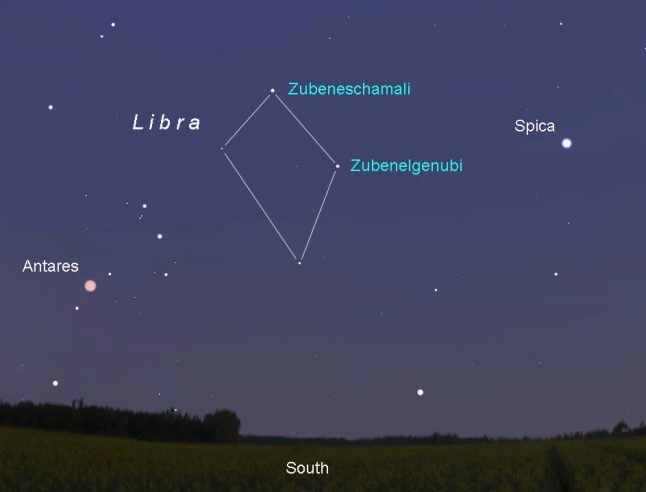

Facing south around 10 p.m. in mid- to late June. Libra is a faint, diamond-shaped pattern of stars. Maps created with Stellarium by AstroBob. Used with permission.
Zubeneschamali, aka Beta Librae, is the brightest star in the constellation Libra the Scales. It’s just a touch brighter than the other bright star in Libra, called Zubenelgenubi. The incomparable Burnham’s Celestial Handbook quotes the star enthusiast Willian Tyler Olcott, who refers to this star as “… the only naked-eye star that is green in color.” Some other stargazers agree. Others don’t. If, indeed, Zubeneschamali is truly green in color, it’s the only green star among the bright stars in the sky.
Zubeneschamali looks blue in this photo, but stargazers call it green. Photo via nikomi.net.
How to find Zubeneschamali. Check this star out for yourself on a Northern Hemisphere summer evening. Assuming you’re in the Northern Hemisphere, it shines high in your southern sky each summer and is easy to find.
Look for Zubeneschamali a good two fist-widths to the northwest (upper right) of the brilliant ruddy star Antares in the constellation Scorpius – one of the few constellations that look like the creature for which it was named. Hold your fist an arm’s length away.
Zubeneschamali is slightly brighter than its brother star Zubenelgenubi. But Zubenelgenubi is designated as the alpha star of the constellation Libra. Why isn’t the brighter star the alpha star of its constellation? It might be because Zubenelgenubi sits on the ecliptic – the annual pathway of the sun in front of the background stars.
If Zubeneschamali doesn’t look green to your unaided eye, try binoculars. Have your friends look at this star too. You might discover that people see colors differently!
Zubeneschamali represents the Northern Claw of the Scorpion in the constellation Scorpius.

The constellation Libra represents the (not always equal) Scales of Justice. Image via thenonist.com.
History and mythology of Zubeneschamali. Both of these star names – Zubeneschamali and Zubenelgenubi – rhyme with Obi-Wan Kenobi of Star Wars fame. They are Arabic phrases meaning the Northern Claw (of the Scorpion) and the Southern Claw (of the Scorpion), respectively. Many thousands of years ago in ancient Babylon, these two stars once belonged to the constellation Scorpius the Scorpion, and once depicted the Scorpion’s outstretched claws.
Apparently, the ancient Greeks and Romans redrew the boundaries, creating the constellation Libra the Scales. Well over 2,000 years ago, the sun on the autumn equinox shone in front of Libra, the balance symbolizing the equal duration of day and night on the equinox. At present, the sun is in front of the constellation Virgo the Maiden on the autumn equinox, which falls annually on or near September 22.
In the star lore of the ancient Greeks, the constellation Virgo represents Astrea, the goddess of justice, holding Libra the Scales and weighing judgment upon human souls. It’s thought that Roman citizens associated Libra with Augustus, the dispenser of divine judgment.
Zubeneschamali science. Science has helped Zubeneschamali to one-up its biggest rival in Libra, the alpha star Zubenelgenubi. Astronomers have determined that Libra’s beta star is considerably brighter intrinsically than its rival Zubenelgenubi. Although these two Libra stars appear nearly the same brightness as seen from Earth, that’s because Zubenelgenubi lies at less than half Zubeneschamali’s distance. Zubenelgenubi is 77 light-years away, whereas it’s 160 light-years to Zubeneschamali. Zubeneschamali’s intrinsic luminosity is nearly five times that of Zubenelgenubi and 130 times that of the sun.
The sun passes in front of Libra from about November 1 to November 22, and the sun has its annual conjunction with Zubenelgenubi or or near November 7.
Zubeneschamali’s position: RA: 15h 17.5m, dec: -9° 25′
Bottom line: Is Zubeneschamali green? Learn about this brightest star in the constellation Libra.
from EarthSky http://bit.ly/2Nbu25E


Facing south around 10 p.m. in mid- to late June. Libra is a faint, diamond-shaped pattern of stars. Maps created with Stellarium by AstroBob. Used with permission.
Zubeneschamali, aka Beta Librae, is the brightest star in the constellation Libra the Scales. It’s just a touch brighter than the other bright star in Libra, called Zubenelgenubi. The incomparable Burnham’s Celestial Handbook quotes the star enthusiast Willian Tyler Olcott, who refers to this star as “… the only naked-eye star that is green in color.” Some other stargazers agree. Others don’t. If, indeed, Zubeneschamali is truly green in color, it’s the only green star among the bright stars in the sky.
Zubeneschamali looks blue in this photo, but stargazers call it green. Photo via nikomi.net.
How to find Zubeneschamali. Check this star out for yourself on a Northern Hemisphere summer evening. Assuming you’re in the Northern Hemisphere, it shines high in your southern sky each summer and is easy to find.
Look for Zubeneschamali a good two fist-widths to the northwest (upper right) of the brilliant ruddy star Antares in the constellation Scorpius – one of the few constellations that look like the creature for which it was named. Hold your fist an arm’s length away.
Zubeneschamali is slightly brighter than its brother star Zubenelgenubi. But Zubenelgenubi is designated as the alpha star of the constellation Libra. Why isn’t the brighter star the alpha star of its constellation? It might be because Zubenelgenubi sits on the ecliptic – the annual pathway of the sun in front of the background stars.
If Zubeneschamali doesn’t look green to your unaided eye, try binoculars. Have your friends look at this star too. You might discover that people see colors differently!
Zubeneschamali represents the Northern Claw of the Scorpion in the constellation Scorpius.

The constellation Libra represents the (not always equal) Scales of Justice. Image via thenonist.com.
History and mythology of Zubeneschamali. Both of these star names – Zubeneschamali and Zubenelgenubi – rhyme with Obi-Wan Kenobi of Star Wars fame. They are Arabic phrases meaning the Northern Claw (of the Scorpion) and the Southern Claw (of the Scorpion), respectively. Many thousands of years ago in ancient Babylon, these two stars once belonged to the constellation Scorpius the Scorpion, and once depicted the Scorpion’s outstretched claws.
Apparently, the ancient Greeks and Romans redrew the boundaries, creating the constellation Libra the Scales. Well over 2,000 years ago, the sun on the autumn equinox shone in front of Libra, the balance symbolizing the equal duration of day and night on the equinox. At present, the sun is in front of the constellation Virgo the Maiden on the autumn equinox, which falls annually on or near September 22.
In the star lore of the ancient Greeks, the constellation Virgo represents Astrea, the goddess of justice, holding Libra the Scales and weighing judgment upon human souls. It’s thought that Roman citizens associated Libra with Augustus, the dispenser of divine judgment.
Zubeneschamali science. Science has helped Zubeneschamali to one-up its biggest rival in Libra, the alpha star Zubenelgenubi. Astronomers have determined that Libra’s beta star is considerably brighter intrinsically than its rival Zubenelgenubi. Although these two Libra stars appear nearly the same brightness as seen from Earth, that’s because Zubenelgenubi lies at less than half Zubeneschamali’s distance. Zubenelgenubi is 77 light-years away, whereas it’s 160 light-years to Zubeneschamali. Zubeneschamali’s intrinsic luminosity is nearly five times that of Zubenelgenubi and 130 times that of the sun.
The sun passes in front of Libra from about November 1 to November 22, and the sun has its annual conjunction with Zubenelgenubi or or near November 7.
Zubeneschamali’s position: RA: 15h 17.5m, dec: -9° 25′
Bottom line: Is Zubeneschamali green? Learn about this brightest star in the constellation Libra.
from EarthSky http://bit.ly/2Nbu25E

Aucun commentaire:
Enregistrer un commentaire